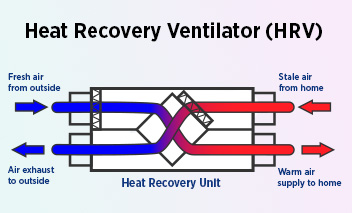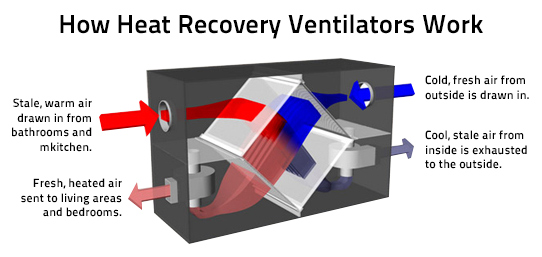Revealing the Key Benefits and Uses of Heat Recovery Ventilation in Lasting Layout
Heat Recovery Ventilation (HRV) systems play an essential role in lasting style. They facilitate a constant exchange of stale indoor air with fresh exterior air, significantly boosting interior air top quality. In addition, HRVs add to energy efficiency by recovering heat from tired air, which can lower energy prices. Understanding the diverse benefits and applications of HRVs exposes their significance in contemporary style. What other advantages do these systems provide in the search of sustainability?
Recognizing Heat Recovery Ventilation Equipments
Heat recovery ventilation (HRV) systems are designed to enhance interior air high quality while minimizing energy loss. These systems make use of a mechanical air flow technique to exchange stale indoor air with fresh outdoor air, making certain a continual supply of clean air. By capturing warm from the exhaust air, HRVs precondition incoming air, lowering the need on home heating and cooling down systems. This procedure not only improves thermal comfort however likewise adds to energy efficiency in property and industrial structures. In addition, HRV systems assist control humidity degrees and lower interior toxins, advertising a healthier living environment. Their tactical application is vital for accomplishing sustainable style goals, as they use an equilibrium between energy conservation and owner wellness.
How HRV Systems Work
While numerous might be familiar with air flow systems, recognizing exactly how warm recuperation ventilation (HRV) systems operate is vital for appreciating their benefits. HRV systems work by trading stagnant interior air with fresh outdoor air while moving warm between both streams. This process occurs in a warm exchanger, where warm from the outgoing air warms the inbound air throughout colder months, minimizing energy loss. Conversely, in warmer months, the system can cool incoming air utilizing the cooler outbound air. HRVs are equipped with fans to facilitate airflow and filters to eliminate particulates, ensuring a continuous, well balanced ventilation procedure. This cutting-edge style not only improves power effectiveness but additionally contributes to maintaining a comfortable interior environment.
Enhancing Indoor Air Top Quality
Interior air quality can considerably impact health and wellness and well-being, making effective air flow necessary in modern-day homes. Heat Recovery Ventilation (HRV) systems play an important role in maintaining indoor air top quality by continually trading stagnant interior air with fresh outside air. This process not only lowers air-borne toxins but likewise reduces humidity levels, which can result in mold growth and respiratory concerns. HRV systems filter incoming air, removing allergens and particulates, thus supplying a much healthier living setting. Additionally, these systems help remove odors and unstable organic compounds (VOCs) generally found in home products. By making certain a consistent circulation of clean air, HRV systems add to a general enhanced interior ambience, promoting convenience and wellness for residents.
Energy Performance and Cost Savings
Energy efficiency stands apart as a considerable advantage of Heat Recovery Ventilation (HRV) systems. By recording and reusing the warm from exhausted indoor air, HRVs lessen the energy needed for heating incoming fresh air, causing decreased energy usage. This effectiveness equates right into lower energy expenses, supplying significant price financial savings for property owners and organizations alike. Additionally, HRV systems usually receive energy effectiveness incentives and discounts, further boosting their monetary charm. Over time, the initial investment in HRV modern technology can result in a positive return on financial investment through decreased energy costs. Subsequently, the integration of HRV systems not only advertises sustainable design yet additionally supplies a practical solution for achieving long-lasting energy financial savings and financial advantages.
Ecological Advantages of HRV

A plethora of environmental advantages occurs from the execution of Heat Recovery Ventilation (HRV) systems. By effectively moving heat from exhaust air to inbound fresh air, HRVs substantially decrease the power required for home heating and cooling rooms. This power efficiency converts to lower greenhouse gas discharges, contributing to a decline in the general carbon impact of structures. In addition, HRV systems enhance indoor air quality by constantly distributing fresh air, therefore lowering the concentration of interior toxins and allergens. The reduction in power intake help in preserving natural sources, making HRVs a necessary element of lasting layout. Overall, the ecological benefits of HRVs play an essential function in promoting a healthier earth and promoting environment-friendly building techniques.
Versatile Applications in Modern Architecture
Heat recovery ventilation (HRV) systems are increasingly being integrated right into both residential and business building projects. In residential settings, HRVs boost indoor air high quality while making best use of energy performance. On the other hand, in commercial spaces, these systems optimize ventilation techniques, showing their adaptability in contemporary building applications.
Residential Projects Combination
While contemporary design significantly stresses sustainability, the combination of heat recuperation ventilation systems in domestic projects has arised as a useful solution for boosting interior air high quality and energy efficiency. These systems effectively move heat from exhaust air to inbound fresh air, decreasing energy loss and reducing home heating or cooling demands. In brand-new builds and retrofits alike, warmth healing ventilation can be seamlessly incorporated, offering property owners with a much healthier living environment while lowering energy prices. Additionally, with boosting understanding of ecological influences, more engineers and building contractors are recognizing the lasting benefits of these systems. Because of this, heat recovery air flow has actually ended up being an essential part of lasting household layout, showcasing versatility and commitment to eco-friendly methods.
Commercial Areas Optimization
As modern-day business areas advance to fulfill the needs of sustainability and performance, the execution of warm healing air flow systems becomes a vital strategy for enhancing indoor environments. These systems promote the exchange of stagnant interior air with fresh outside air while redeeming heat, significantly reducing energy intake. This not only enhances convenience for passengers but likewise aids in reducing operational costs. Functional applications can be observed in offices, retail spaces, and educational organizations, where air quality and temperature level control are paramount. Additionally, integrating heat recovery ventilation lines up with eco-friendly building qualifications, better advertising environmental obligation. Inevitably, taking on such systems in business style not only adds to sustainability goals yet additionally fosters much healthier, extra efficient rooms for users.
Incorporating HRV Into Sustainable Style Practices
Incorporating warmth recovery air flow (HRV) systems into lasting layout methods supplies significant advantages in energy performance and interior air high quality. By using HRV, developers can produce economical solutions that not only lower energy consumption however likewise enhance the general convenience of indoor atmospheres. This positioning with sustainability objectives placements HRV as a vital part in contemporary building approaches.
Power Effectiveness Improvement
By including heat recuperation air flow (HRV) systems right into lasting layout methods, engineers and builders can significantly improve energy efficiency in modern-day building and constructions. websites HRV systems operate by recording warm from outgoing stale air and moving it to incoming fresh air, lessening the power needed for home heating or cooling indoor areas. This process not just minimizes dependence on traditional HVAC systems yet additionally decreases overall power consumption. Additionally, HRV systems can assist keep a constant indoor temperature level, lowering Home Page peak energy demands. By incorporating these systems, buildings can accomplish substantial reductions in utility expenses and carbon footprints, aligning with sustainability objectives. Inevitably, HRV innovation stands for a useful option for enhancing power performance in the constructed setting, advertising even more liable resource usage.
Indoor Air Quality Enhancement
How can warm recovery air flow (HRV) systems add to superior interior air high quality in contemporary structures? HRV systems effectively exchange stale indoor air with fresh outside air while recovering warm power, decreasing temperature changes. This procedure decreases the focus of interior pollutants, such as unstable natural substances (VOCs), irritants, and wetness, which can deteriorate air top quality and effect passenger wellness. By preserving optimal moisture levels and ensuring a continual supply of tidy air, HRVs help produce a much healthier indoor environment. Furthermore, these systems can be integrated into sustainable style practices, advertising power performance together with improved air high quality. HRV Heat Recovery Ventilation. As a result, HRV innovation plays an important role beforehand overall passenger comfort and health in contemporary building layouts
Cost-efficient Style Solutions

Regularly Asked Questions
What Maintenance Is Required for Heat Recovery Ventilation Solutions?

Maintenance for warm recuperation air flow systems generally involves routine filter replacements, cleansing of warm exchangers, examination of followers and air ducts, and making certain correct drain. These tasks help maintain effectiveness and extend the system's life-span in time.
Can HRV Equipments Be Mounted in Existing Buildings?
Heat recovery ventilation systems can certainly be installed in existing buildings. HRV Heat Recovery Ventilation. Retrofitting requires careful planning and assessment of the structure's format, ensuring compatibility with present systems while making best use of energy effectiveness and interior air top quality
Exactly How Do HRV Equipment Impact Noise Levels Inside Your Home?
HRV systems can influence interior sound levels by presenting sound from external sources through air flow. However, high-quality installments usually integrate sound-dampening features, lessening sound effect while providing effective air exchange and maintaining comfort inside your home.
Exist Any Type Of Disadvantages to Utilizing HRV Equipments?
The downsides of making use of HRV systems include prospective high initial costs, maintenance challenges, and the opportunity of lowered interior air high quality if filters are not frequently transformed, which can lead to issues with moisture levels.
Just how Do I Choose the Right HRV System for My Demands?
Picking the appropriate warmth recovery air flow system learn the facts here now includes assessing certain demands, such as building dimension, environment, and energy performance goals. Furthermore, reviewing system functions, installment requirements, and maintenance factors to consider is vital for peak efficiency and fulfillment.